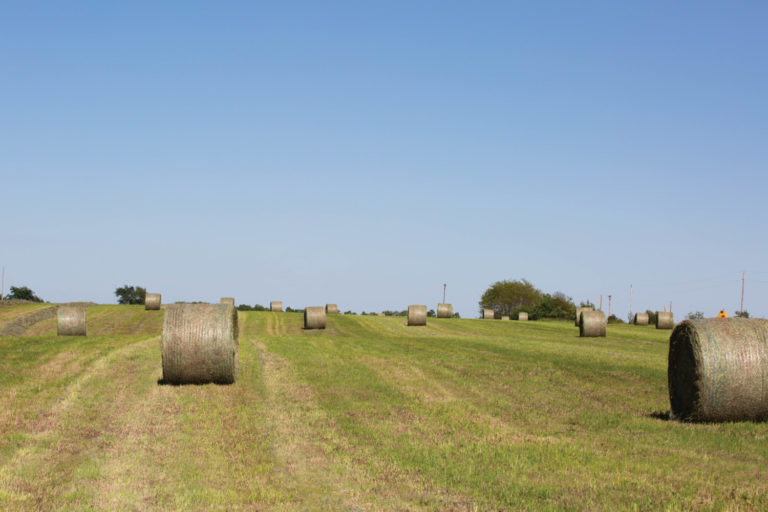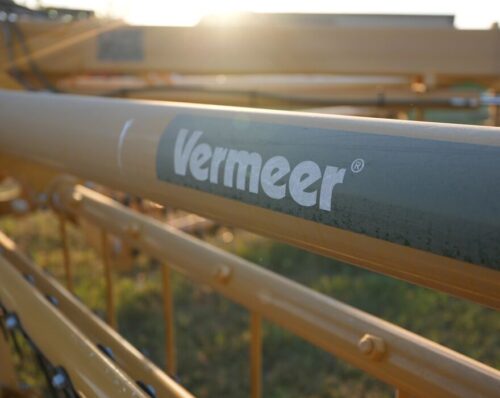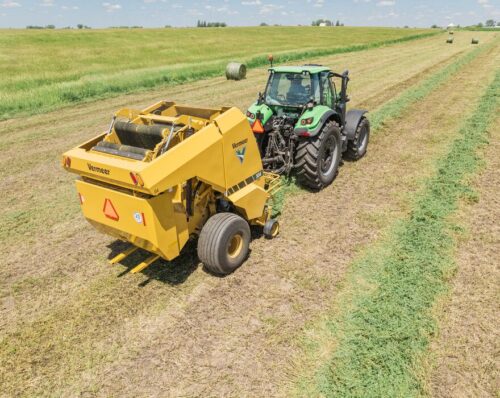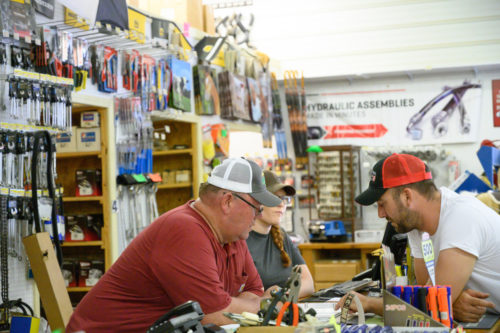
Buy hay the right way
May 2019
Hay quality, bale size are key variables to consider when buying
Buying hay and forage — from high-quality alfalfa to feed your cattle all the way down to the lowest quality bedding material for barns and feedyard pens — is different than with most other crops. It’s entirely based on local market conditions, namely the supply of the right type of hay to meet your needs as a buyer.
Without a national exchange — like the Chicago Board of Trade for corn and soybeans, for example — how do you meet the seller at the right price point?
“The thing that’s so challenging about hay and forage markets compared to corn and soybeans is that when we’re talking about corn, we’re talking about No. 2 yellow corn, and that is the industry standard. Because of the variables involved in buying hay — especially standing hay — the price for one transaction is not necessarily a reasonable price in another. The variables underlying those prices, as well as growing and supply/demand conditions are totally different,” according to Waupaca County University of Wisconsin Extension Agriculture Agent Greg Blonde.
“With hay, there’s a quality estimate based on relative forage quality (RFQ) and also what kind of a package it’s in — large square, small square or round bales. It just makes it tough.”
Blonde has been working in the hay and forage marketplace in Wisconsin for almost four decades, a time during which he’s noted a trend in how buyers and sellers reach common ground, especially in recent years. As an Extension specialist, he’s been accustomed to phone calls from farmers around his region, but both the frequency of those calls and the type of information hay buyers and sellers seek have grown the last few years.
“Over my career, I’ve had more requests recently for forage pricing information, which makes sense as our industry becomes more consolidated with fewer but larger operations,” Blonde said. “In many cases, larger operations are not only growing their own feed source but purchasing larger quantities of feed from nearby retired farms to fill increasing needs.”
Identify hay type
Negotiating the right price for a hay sale starts with clearly identifying your wants and needs as a buyer. In some cases, buyers may opt to purchase standing hay and manage the labor of harvesting and baling themselves, while in other cases, they’re looking for specific bale sizes and types of forage depending on the operation. Confirming these specific variables upfront makes it easier to zero in on the right price point, Blonde said.
Negotiating the price for standing hay typically involves accounting for yield potential and labor costs to harvest and bale hay, regardless of which party is responsible for those field operations. It also includes a price premium that accounts for weather risk, especially for higher grades of alfalfa hay.
“When you’re buying standing hay, you’re literally just purchasing what’s available above ground. There’s a lot of land out there where the land is still owned by retired farmers, and they don’t want to give up total control of the land by simply renting it all out. There’s a fair amount of hay ground that’s bought and sold as standing hay every year,” Blonde said. “If you’re a buyer pricing a whole year of standing hay in advance and if you don’t have a good sense for the weather risk involved, there is an option of putting in a weather-risk-loss value, as much as 10 or 20 percent — especially with alfalfa that tends to be higher quality but more susceptible to quality loss if it gets wet and you can’t get into the field. And if you’re buying, you want to subtract your contribution to getting that stand into a harvested form, whether you’re chopping or baling.”
Know your RFQ needs
Once you know the hay type you’re purchasing, quality is the next big variable to confirm before making a deal. The first step is knowing how hay quality is rated. The most up-to-date value scale that’s used to quantify hay quality based on its value as a feedstock, RFQ was introduced in 2002 to improve upon the previous scale for rating hay, relative feed value (RFV). Both scales are used to rate hay in many U.S. Department of U.S. Department of Agriculture’s (USDA) Agricultural Marketing Service (AMS) weekly hay market reports, and while the formulas comprising them do differ, both RFQ and RFV ratings provide a strong understanding of hay quality. The higher hay’s RFQ, the more value it has as a feed supply, with ratings ranging from “supreme” to “utility.” Each category — supreme, premium, good, fair and utility — covers a range of feed value. Alfalfa rated “supreme” has an RFQ or RFV of 185 or greater, while utility hay is rated 130 or lower. Each category also has a corresponding total digestible nutrient (TDN) percentage value range and a crude protein rating. A hay supply’s TDN is a key variable to watch when it comes to first assessing RFQ, then later accounting for it in negotiating the right hay sale price.
Find the right bale size
For baled hay, a key early pricing benchmark is bale type and size. Small squares typically fetch much higher per-ton prices than larger bales because of the labor involved in producing them. On the other end of the spectrum, large round bales typically carry the lowest per-ton cost. Blonde said he uses large square bales as his per-ton price benchmark size because they typically occupy the middle ground between large round bales for larger, commercial-type operations and small square bales more likely to be purchased by equine operations or hobby farms.

Start at the right reference price
Once you’ve determined the hay type, quality and bale size for the transaction, the next step is finding a starting point for price negotiations. USDA AMS reports hay sales each week for different major sales points in the top 20 hay-producing states in the U.S., with prices listed for a range of hay types and quality levels, from mixed grass hay and cornstalks to supreme quality dairy alfalfa. The University of Wisconsin also has a weekly hay price reporting tool for much of the Midwest, as well as a mobile app for hay pricing.
After you’ve identified the right starting price point based on the best available price index data for your location, hay quantity and quality, it’s important to take into account variables like local supply and demand factors and the availability of the specific hay quality and bale size you’re after as a buyer. Blonde recommends checking more than the most recent local hay market information in negotiating the right hay price. The quest for broader information is aided by a mobile app Blonde and his University of Wisconsin Extension colleagues developed to help buyers and sellers reach a fair sale price. “We try to build all relevant variables into our mobile app, so that depending on whether you’re a buyer or seller, you enter the variables you like to use to come up with a value that can work for you,” Blonde said. “In the past, when I’d get a call about buying or selling hay — whether harvested or standing — I’d have to dig up the relevant market report or look for AMS reports, use those as the starting point, then move the price and yield data into the equation. We account for bale size, hay and forage quality, and any work that must be done to harvest the hay, in the case of standing hay.
“With any market, the more price discovery you can do, the better,” Blonde added.
Taking into account bale size, quantity and general hay quality are critical to making a good hay deal.
Continue to learn more at Be a smart hay negotiator with these tips.






